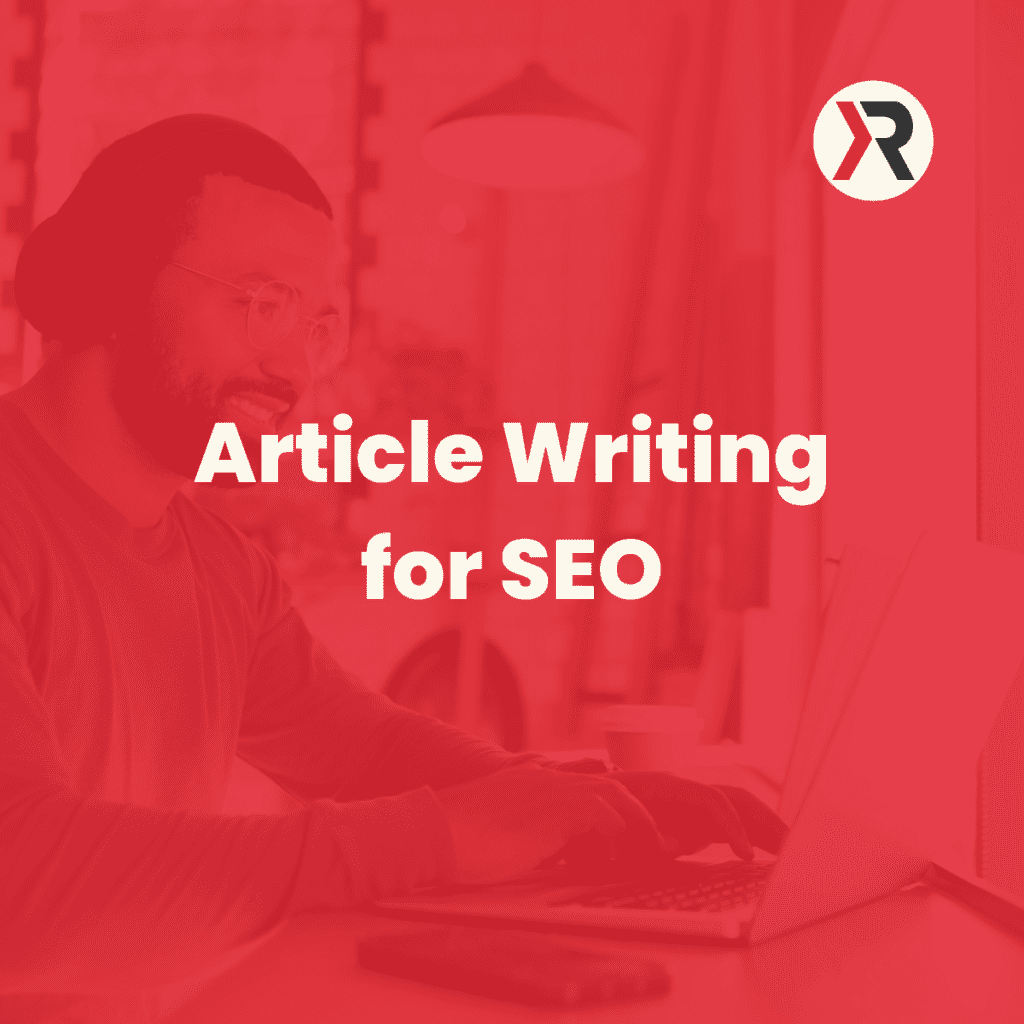Mastering Article Writing for SEO and Higher Rankings
In the competitive world of online content, ensuring your blog posts rank well on search engines like Google is crucial for driving traffic to your website. However, with countless blogs vying for attention, standing out requires mastering the art of SEO writing.
Understanding SEO Writing for Search Engines
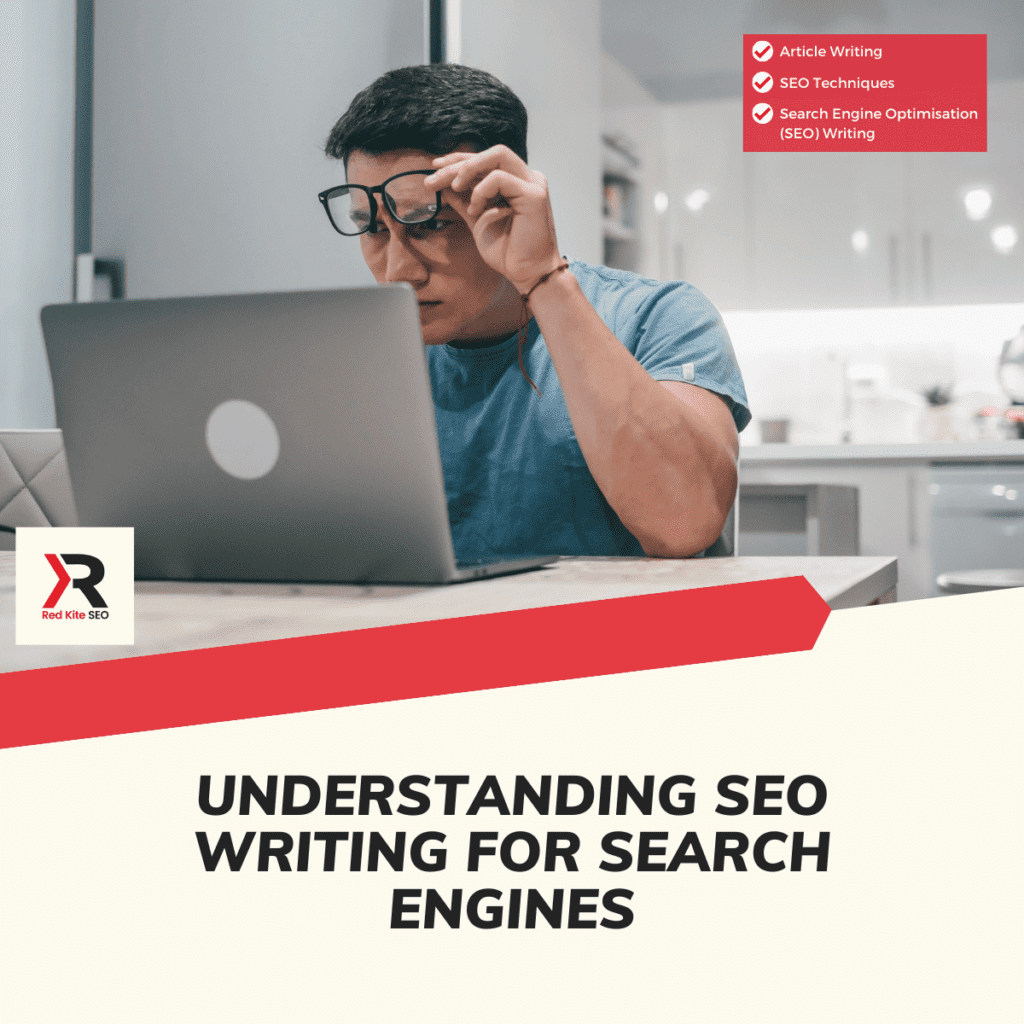
Search Engine Optimisation (SEO) writing is a form of writing that helps websites rank higher in search engine results pages. It involves writing content that is optimised with relevant keywords and phrases that users are likely to search for.
By incorporating SEO techniques into your writing, you can improve your own site or website’s visibility and attract more organic traffic. Some key tips for SEO writing include using relevant keywords, creating high-quality content, and optimising meta tags and descriptions.
SEO writing, also known as search engine optimisation writing, involves crafting content that ranks highly on search engine results pages (SERPs). This process includes meticulous keyword research, aligning content with user intent, and optimising various elements for search engine crawlers.
Why SEO Writing Matters
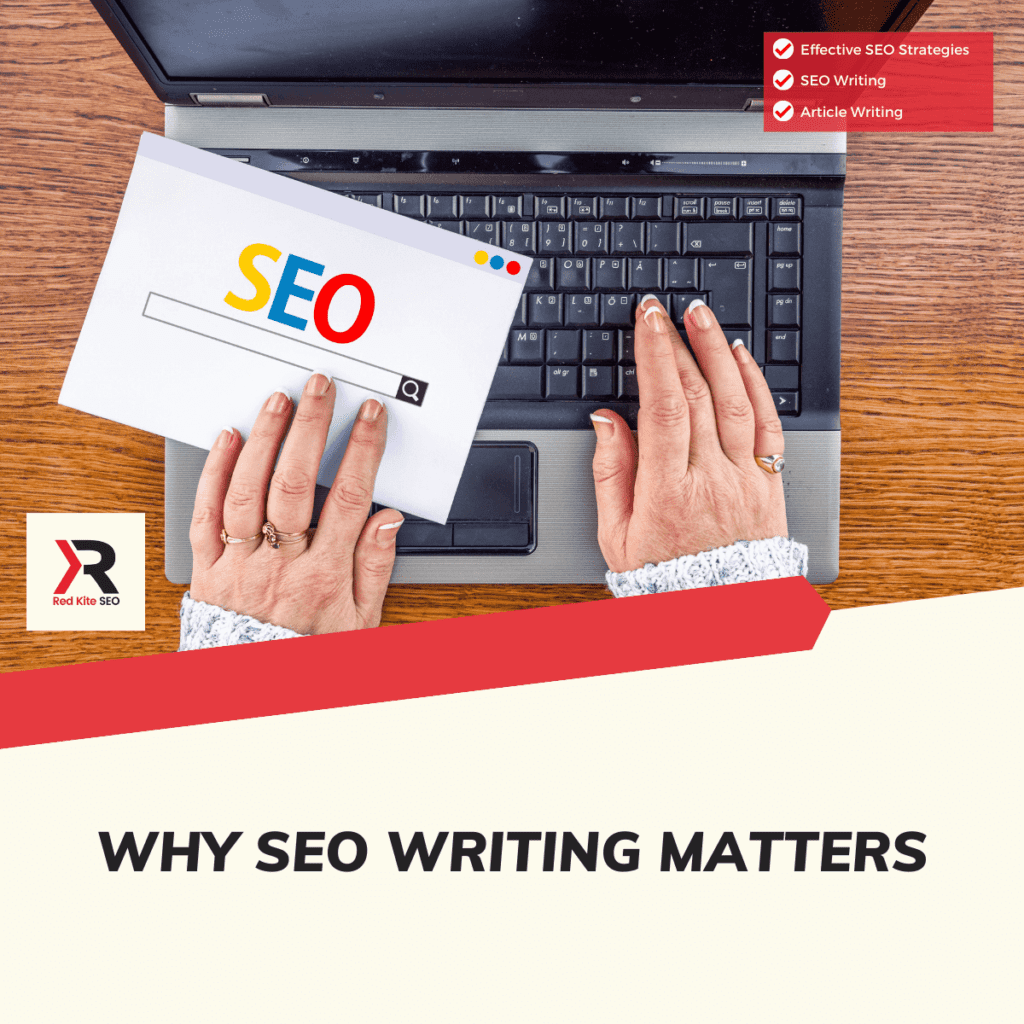
Effective SEO strategies are essential for top ranking pages preventing your blog posts from being buried in the lower pages of search results. Higher rankings drive organic traffic, and lead to increased visibility, organic traffic, and ultimately, business success.
The Basics of SEO Content Writing
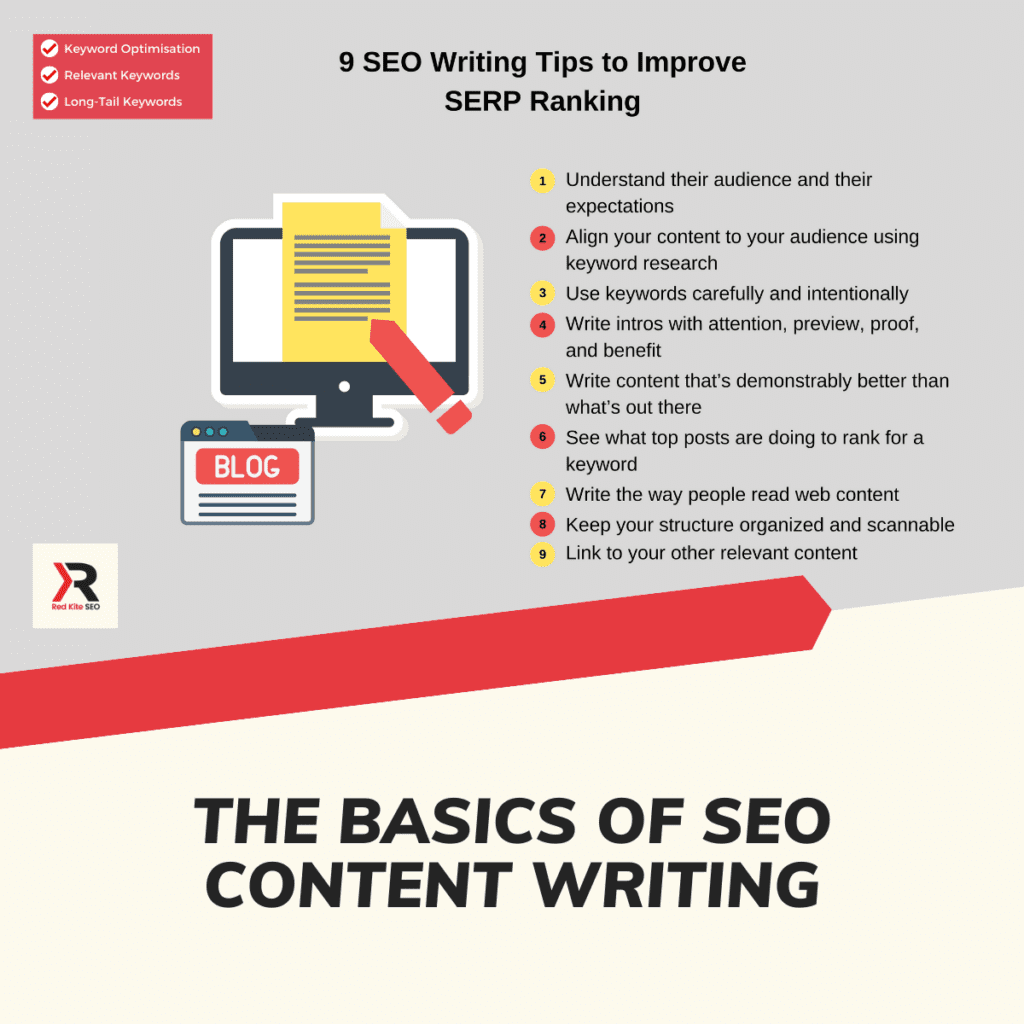
Keyword Optimisation
1. Identify Relevant Keywords: Utilise tools like Ahrefs or Google Keyword Planner to identify high-value keywords relevant to your target keywords and audience.
2. Strategic Incorporation: Integrate keywords naturally into your content, including page titles, headings, and body text, to enhance visibility and relevance.
Finding the Right Relevant Keywords for Your Articles
The quest for the perfect keywords may feel daunting, but fear not! Here is a simple guide to navigate the realms of keyword research:
-
- Brainstorm potential keywords: Start by jotting down terms related to your content’s topic.
- Use keyword research tools: Leverage tools like Google Keyword Planner or SEMrush to expand your list and gather data on search volume and competition.
- Analyse the competition: Look at what keywords industry leaders are ranking for and how your content can provide a unique perspective.
- Consider keyword intent: Understand the purpose behind search queries-whether users are looking to buy, learn, or find specific information.
The Importance of Long-Tail Keywords
Did you know that more specific, often longer search phrases, known as long-tail keywords, can be incredibly effective for driving targeted traffic to your articles?
These are the gems that represent more nuanced queries and can lead to higher conversion rates as they cater to very specific user interests. Including long-tail keywords helps your article stand apart from the generic buzz and directly answer the searcher’s question.
Incorporating long-tail keywords into your content can be a game-changer, especially when trying to gain traction in a field dense with competitors. It’s about reaching those who are seeking exactly what you’ve got to offer and providing immense value when they land on your page.
In conclusion, master the art of keyword research, and you’ll craft content that not only ranks but also genuinely connects with your audience. Embrace this step, and watch as your articles gain the visibility they deserve.
Example:
- WordPress users can seamlessly incorporate keywords across their content sections, including titles, meta descriptions, and URLs. (using an SEO plugin)
- Squarespace simplifies keyword optimisation through its dedicated SEO settings, allowing users to input keywords for titles, meta descriptions, and URLs.
- Wix users can optimise keywords using the SEO Wiz tool.
Understanding User Intent
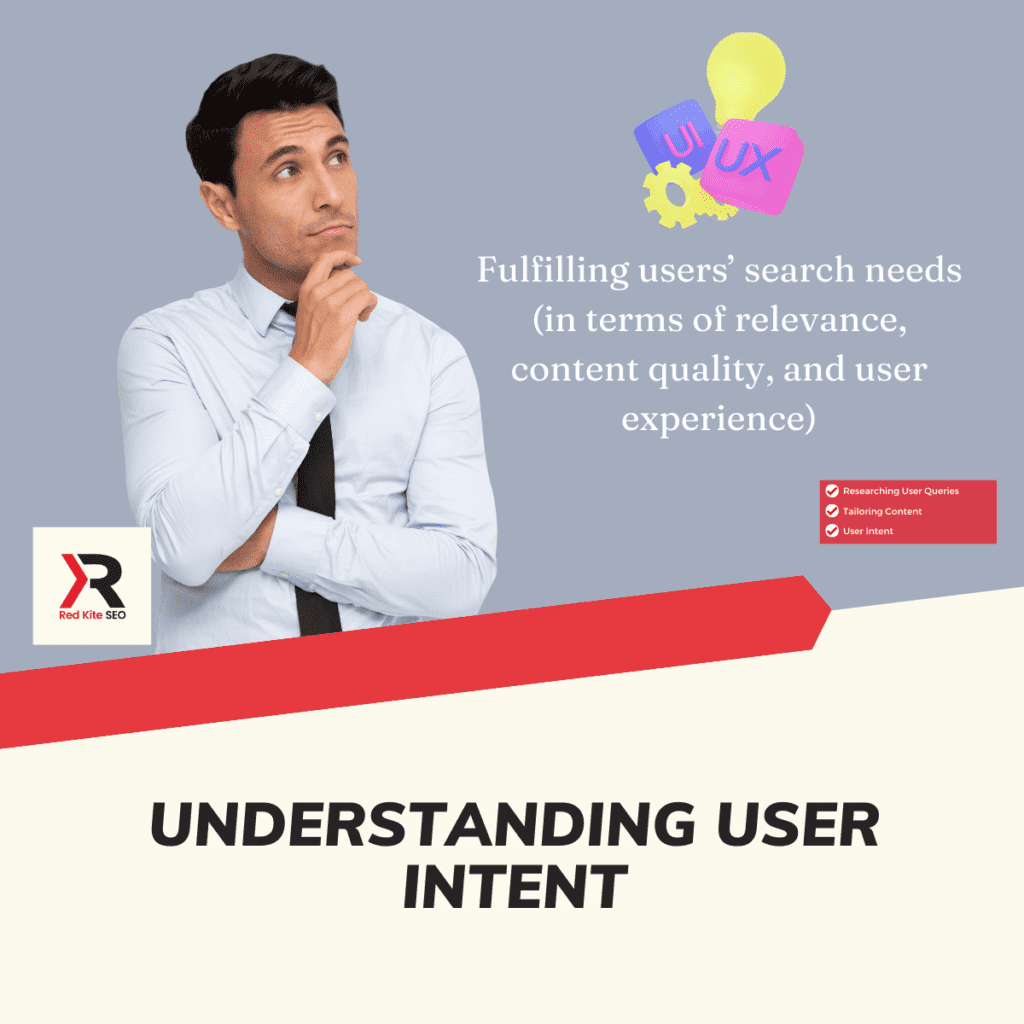
- Research User Queries: Gain insights into the intent behind users’ search queries.
- Tailor Content: Develop content that effectively addresses user needs and aligns with search intent.
Getting to grips with search intent is foundational to crafting SEO-friendly articles that hit the mark. Users have a specific intent or goal in mind when they type a query into a search engine. As a content creator, you need to unveil the purpose behind the search to ensure that your content aligns perfectly with your audience’s needs.
Breakdown of Different Types of Search Intent
Generally, search intent falls into a few main categories:
-
- Informational Intent: When users are looking for information. This could be a quick answer to a question or in-depth research on a specific topic.
- Navigational Intent: When users want to find a specific website or page. They usually already have a destination in mind.
- Transactional Intent: When users are ready to buy or perform another type of transaction. They’re looking for a place where they can make a purchase or complete another action.
- Commercial Investigation: When users intend to buy in the near future and are in the process of researching their options.
How to Align Your Articles with the Correct Search Intent
Once you understand the different types of intent, the next step is to ensure your content meets the users where they are in their journey:
-
- For informational queries, create informative blog posts, guides, and tutorials that provide valuable insights and answers.
- For navigational queries, ensure your site’s branding is consistent so users recognise your name and optimise for branded keywords.
- For transactional queries, craft content that showcases your products or services and includes clear calls to action.
- For commercial investigations, write comparison articles, reviews, and buyer’s guides that help users make informed decisions.
Remember, aligning your content with search intent is a key step in fulfilling the expectations of both your audience and search engines alike. When you get this right, not only does it contribute to a better user experience, but it can also improve your organic search rankings!
Example: WordPress users can analyse common user queries within their niche and craft content to directly address those queries. Squarespace users can leverage popular search terms related to their topics to tailor content accordingly. Wix users should focus on providing comprehensive answers to user queries within their content.
Prioritise Readability
Engaging Content: Create content optimised for both search engines and human readers, ensuring it is engaging and easy to comprehend.
Example: Employ short paragraphs and bullet points to enhance readability. WordPress offers a range of reader-friendly themes and font options. Squarespace users can adjust font styles and sizes for improved readability. Wix provides customizable templates with built-in readability features.*
Historical Optimisation
Regular Updates: Periodically review and optimise older blog posts to maintain relevance and competitiveness in search rankings.
Example:
- WordPress users should regularly revisit older posts, updating content and refreshing keywords as needed.
- Squarespace users can utilise the “Analytics” section to identify underperforming content for updates.
- Wix users should monitor traffic to older posts and make updates based on performance metrics.
Crafting an SEO-Friendly Content Structure
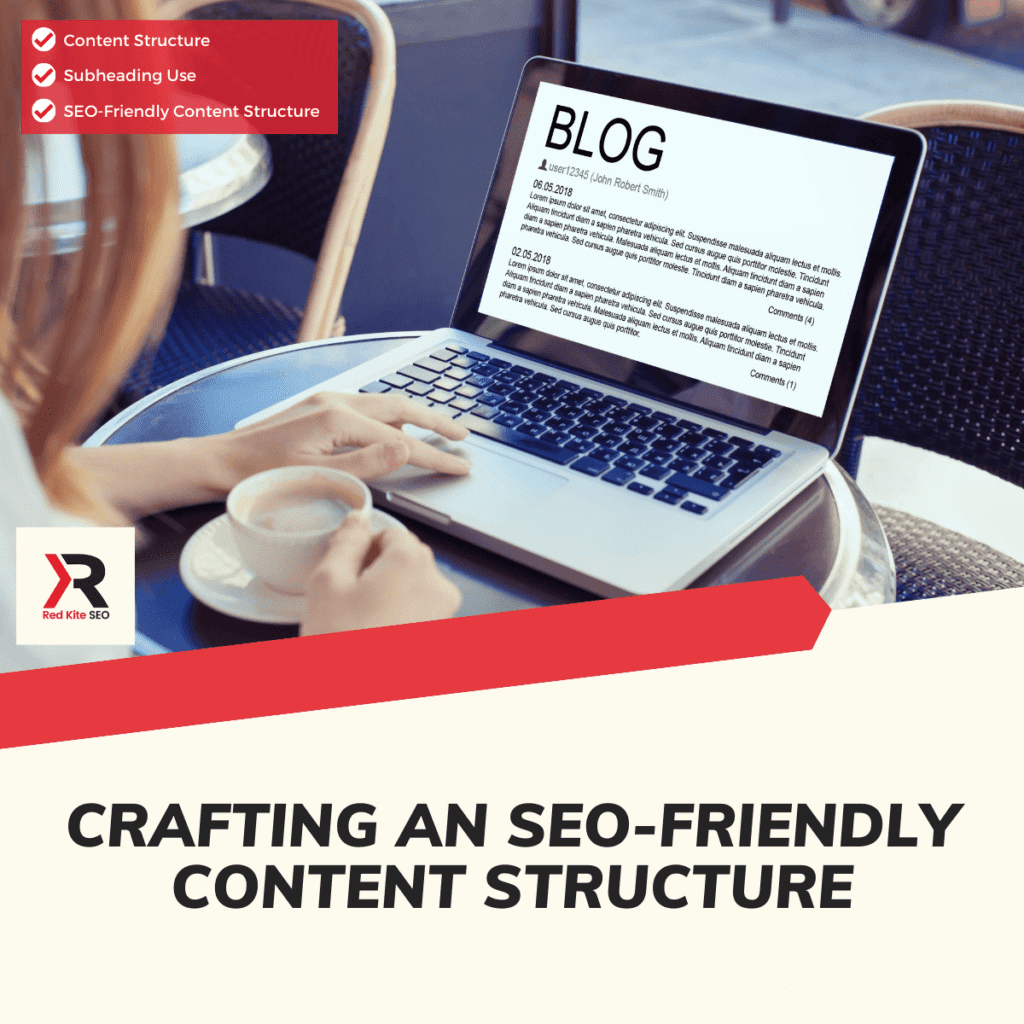
When it comes to article writing for SEO, how you arrange your content is just as crucial as what you write. Think of your article as a house where the structure gives shape to the overall design and guides visitors to their desired destination. Without a clear structure, readers can get lost, and search engines might not grasp the main themes of your content, affecting your high ranking in various search engines’ results.
The Importance of Content Structure for Readability and SEO
A well-organised article does more than just appeal to the reader’s eye. It makes your content easier to digest, ensuring that visitors stick around longer, which search engines interpret as a signal of quality and relevance. Readability and SEO go hand in hand; readers should be able to skim through your article and still understand the key points you’re conveying.
Subheading Use for Enhanced Page Organisation
Think of subheadings as signposts that guide your readers through the text. They break up long blocks of text, making the content more approachable and engaging. Subheadings, especially when wrapped in H2 and H3 tags, also provide SEO benefits. They give search engines hints about the subsidiary topics within your content, aiding in keyword context, and can lead to featured snippet opportunities in the search results.
-
- Use H2 tags for main section titles.
- Use H3 tags for subsections that fall under the H2 umbrella.
- Implement keywords judiciously in your subheadings to support your SEO strategy.
Mastering the craft of an SEO-friendly content structure will not only benefit your readers but also improve the visibility of your articles in search engine results. Keep the structure clear, use headings to their full advantage, and watch your SEO performance grow.
Tips for Effective SEO Writing
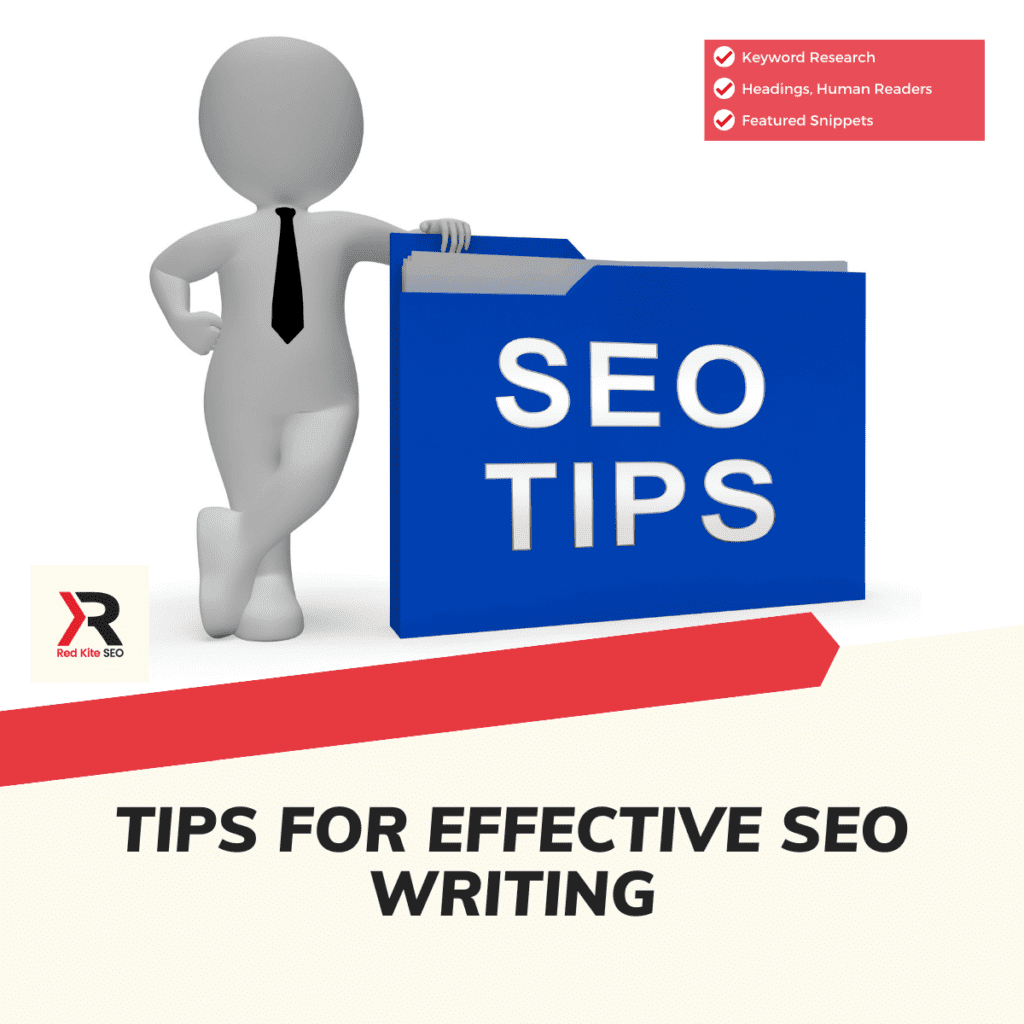
Start with Keyword Research
Identify Keywords: Utilise tools like Ahrefs or Google Keyword Planner to identify high-value keywords relevant to your target keyword and audience.
Example: WordPress users can leverage plugins like Yoast SEO for keyword suggestions and analysis. Squarespace provides keyword research tools within its SEO settings. Wix users can explore various keyword ideas and trends using the Wix SEO Wiz tool.*
Harness the Power of Headings
Clear and Descriptive: Utilise clear and descriptive headings to structure content and indicate relevance to search engines.
Example: Employ appropriate H1, H2, and H3 tags to organise content hierarchy effectively. WordPress users can select heading styles from the formatting toolbar. Squarespace users can format headings using the “Edit” options. Wix offers customizable heading styles within its editor.*
Optimise for Featured Snippets
Craft Concise Answers: Provide concise, informative answers to common search queries to increase the chances of appearing in featured snippets.
Example: Offer direct answers to common questions within content. WordPress users can optimise for featured snippets using plugins like Rank Math. Squarespace users should focus on providing clear answers within the content. Wix users can optimise content for featured snippets using the SEO Wiz tool.*
Prioritise Human Readers
Create Value: Emphasise the creation of valuable, engaging content that resonates with the audience.
Creating website content that makes sense for human readers is essential for engaging and connecting with your audience. Here are some tips to create content that resonates with human readers:
- Understand your audience: Research your target audience to understand their needs, preferences, and interests. Tailor your content to address their pain points and provide valuable information.
- Use a conversational tone: Write blog posts in a clear and conversational tone to make your content easy to read and understand. Avoid using jargon or technical language that may alienate readers.
- Tell a story: Use storytelling techniques to make your content more engaging and relatable. Stories help create an emotional connection with readers and keep them interested in your content.
- Use visuals: Incorporate images, videos, infographics, and other visual elements to enhance your content and make it more appealing to readers. Visuals can help break up text and make your content more engaging.
- Provide valuable information: Ensure that your content provides valuable information, insights, or solutions to your readers’ problems. Focus on delivering high-quality content that adds value to your audience.
By following these tips, you can create website content that is engaging, informative, and tailored to human readers.
Example: Address audience pain points and provide actionable solutions.
Ensuring Content Relevance and Quality
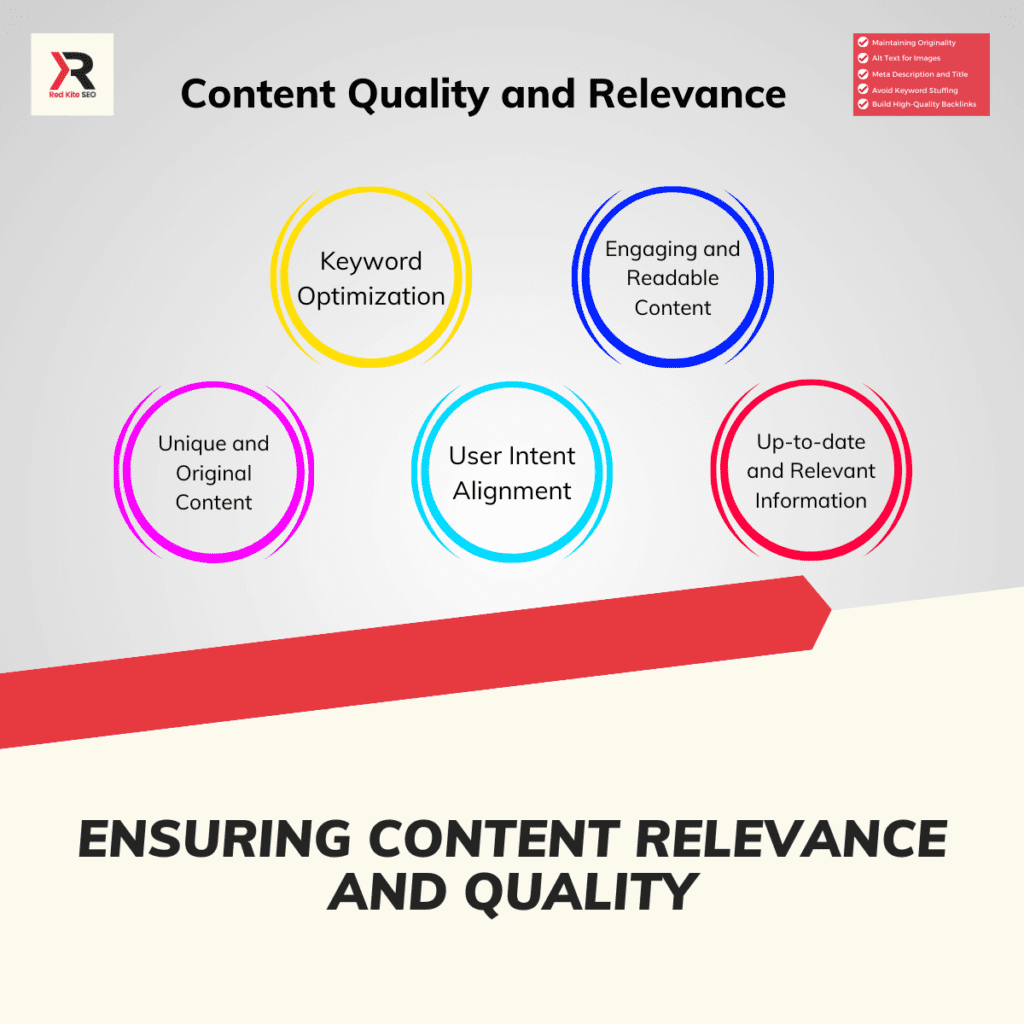
At the heart of every successful SEO strategy lies the unyielding commitment to high-quality, relevant content. Search engines are smarter than ever before, and they prioritise articles that provide value to the reader. So, how do we keep our content not only relevant but also unique and original?
Maintaining Originality and Steering Clear of Plagiarism
Originality in article writing is pivotal for standing out in the crowded, digital marketing landscape. It’s not just about avoiding the legal and ethical pitfalls of plagiarism; it’s about showcasing your unique voice and perspective. Here’s how you can ensure your articles are genuinely original:
-
- Use plagiarism detection tools: Before publishing your content, always run it through a reliable plagiarism checker to ensure it’s free from unintentional duplication.
- Paraphrase effectively: If you need to reference existing information, make sure to put it in your own words. This not only bypasses plagiarism but can also help clarify complex information for your readers.
- Cite your sources: Whenever you’re citing statistics, quotes, or studies, give proper credit to the original authors to maintain transparency and authenticity.
Above all, remember that quality matters just as much as keyword optimisation. A well-written, insightful article can engage visitors, prompt shares, and attract backlinks naturally, which all boost SEO over time.
Craft Compelling Meta Description and Title
Incorporate Keywords: Create attention-grabbing titles that incorporate relevant keywords to improve click-through rates.
Writing compelling headlines is a key skill for engaging readers. Here are some tips to help you write compelling headlines:
- Use action words: Start your headline with a strong verb to grab the reader’s attention.
- Be specific with attractive title: Make sure your headline clearly conveys what the article is about.
- Keep it concise: Aim for a headline and anchor text that is clear and to the point.
- Use numbers: Headlines with numbers tend to attract more clicks.
- Ask a question: Pose a question that piques the reader’s curiosity.
- Use emotional triggers: Appeal to the reader’s emotions to make your headline more compelling.
- Test different headlines: Try out different headlines to see which ones resonate best with your audience.
By following these tips, you can create headlines that are more likely to capture the interest of your readers.
Note: Develop descriptive titles containing primary keywords.
Enhance Meta Descriptions
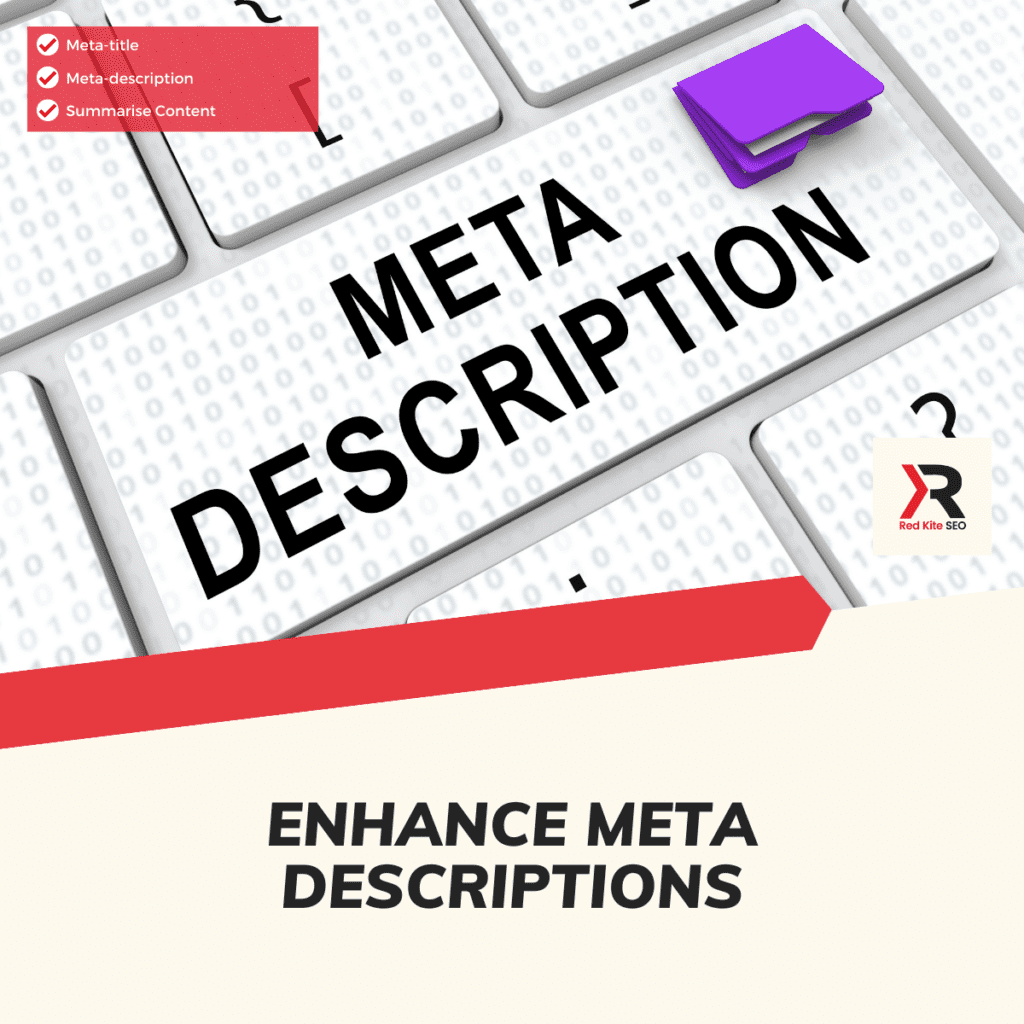
Summarise Content: Compose compelling meta descriptions summarising content and enticing users to click.
Meta-title: use up to 60 – 70 characters (including spaces) and using your title tag keyword.
Meta-description: Use up to 160 characters to give a brief summary of what your webpage/post is about, keep it interesting and use your keyword.
Example: Write concise summaries accurately representing content.
- WordPress users can customise meta descriptions using SEO plugins.
- Squarespace provides meta description settings for each page.
- Wix users can edit meta descriptions within the page settings.
Include Alt Text for Images
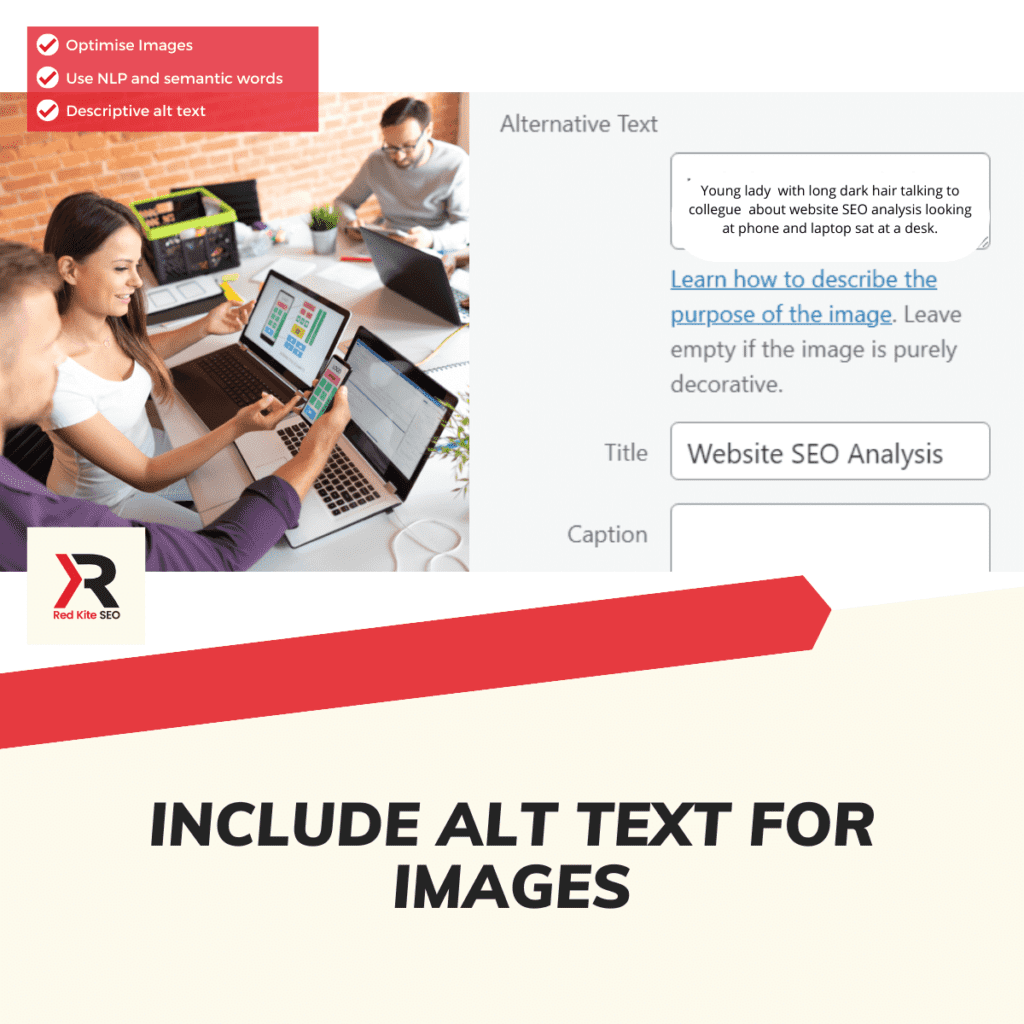
Optimise Images: Optimise images with descriptive alt text to improve accessibility and SEO. Use NLP and semantic words where possible. Overall, keep the alt descriptions accurate for screen readers to explain clearly to anyone with sight impearment.
Example: Utilise descriptive alt text reflecting image content and relevant keywords.
- WordPress users can add alt text in the image block settings.
- Squarespace users can add alt text in the image settings.
- Wix offers alt text options for images within the editor.
Avoid Keyword Stuffing
Natural Density: Maintain a natural keyword density to preserve readability and content quality. The old metric was between 2% – 3% main keyword usage.
This was to avoid overuse of a keyword on a single page, called “keyword stuffing”.
Example: Emphasise natural language and readability. Tools like SEO Surfer analyse and guide you to not over use main keywords.
Build High-Quality Backlinks
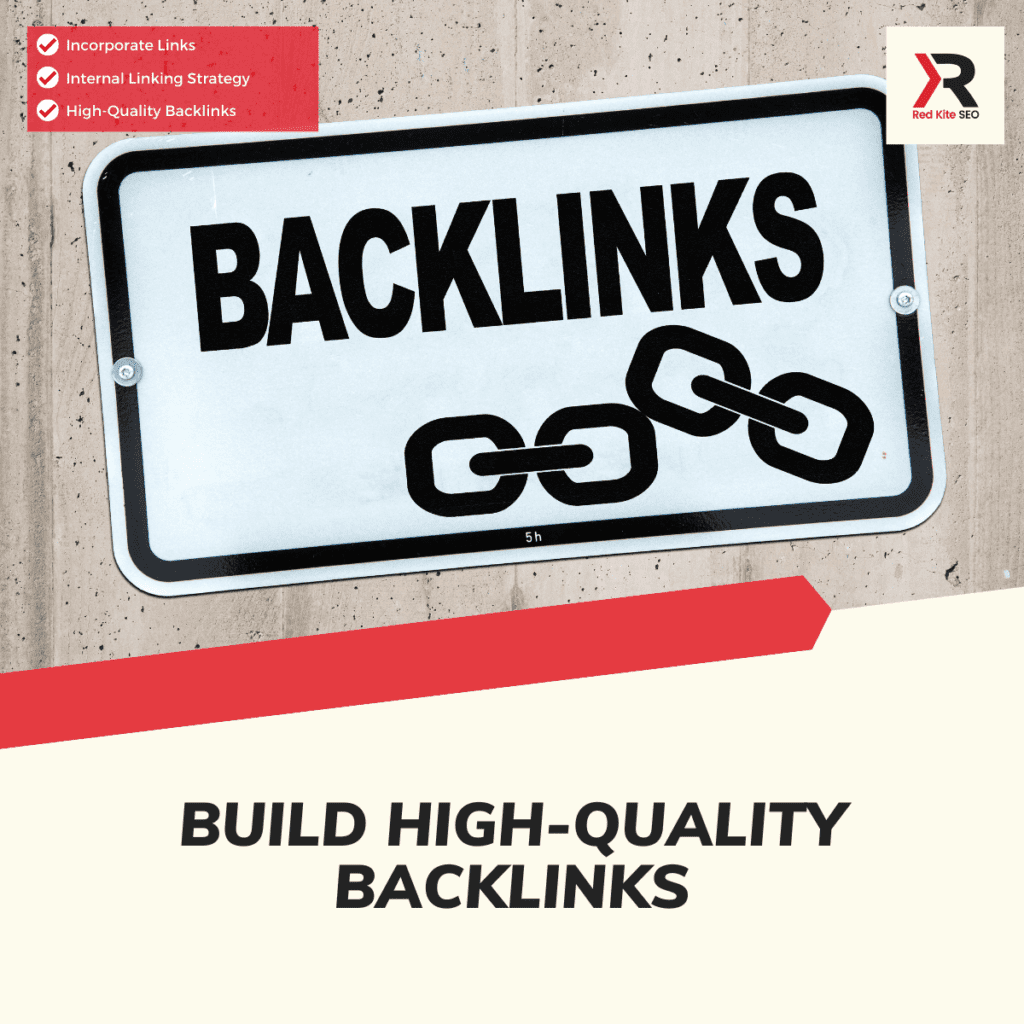
Incorporate Links: Include links to other websites more trusted sites, and reputable sources to enhance content credibility and authority.
-
- Keep your backlinks relevant to your topic and industry.
- Guest posting on other relevant websites will help.
- Sites like Forbes, the BBC, Amazon, Google, Wikipedia and IBM are trusted and authoritative.
Example: Depending on your internal linking strategy, incorporate relevant links to authoritative sites within content.
Optimise for Readability
Comprehensive Content: Create longer, comprehensive blog posts providing value while maintaining scannability and readability.
This would use what is called a pyramid structure.
-
- Main page maybe 2000 – 10000 words long, and cover every aspect of the topic you want to rank for.
- Then you will write a series of shorter supporting articles 1000 – 1500 words long.
- Linking these supporting posts to your main website page.
Example: Divide content into sections with clear headings and subheadings, add diagrams, videos, statistics, quotes, images, how to sections, examples to reviews.
Internal Linking Strategy
Improve Navigation: Link to relevant internal pages to enhance navigation and encourage people search and further exploration of the website.
-
- Keep your content in categories.
- Link to each post within the same category.
- Use keywords and keyword phrases to create a text link.
Example: Include internal links to related posts or web pages only.
- WordPress users can use plugins like Internal Link Juicer for automatic internal linking.
- Squarespace users can manually add internal links within the content editor.
- Wix offers internal linking options within the editor interface.
Optimise Page Load Speed
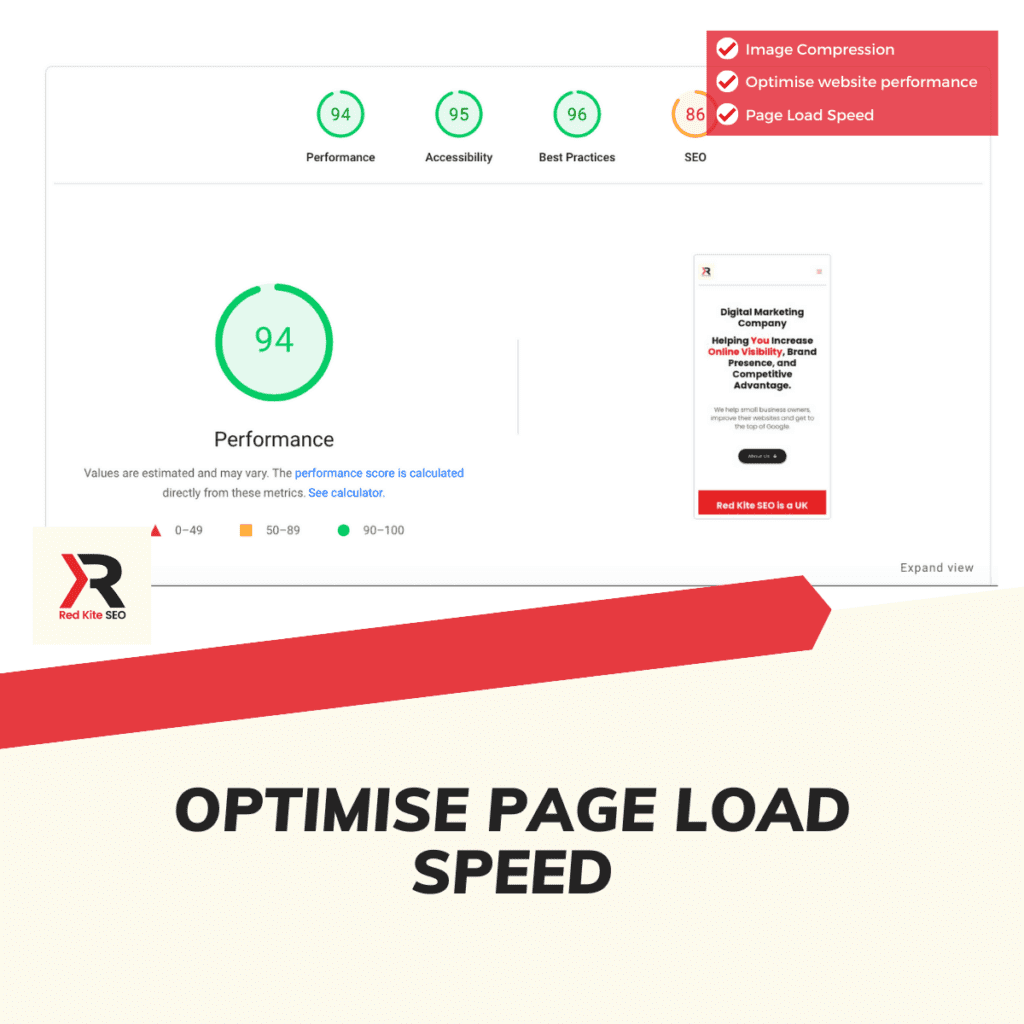
Image Compression: Compress images and optimise website performance for a seamless user experience and improved search rankings.
-
- Webp is a light weight image option.
- Use the most common size images on your website.
- Choose mobile image sizes over desktop hero images.
- Compress images before upload.
Example: Resize and compress images before uploading.
- WordPress users can use plugins like WP Smush for image optimisation.
- Squarespace automatically optimises images for faster loading.
- Wix users can optimise images using the built-in image editor.
Develop a Link-Building Strategy
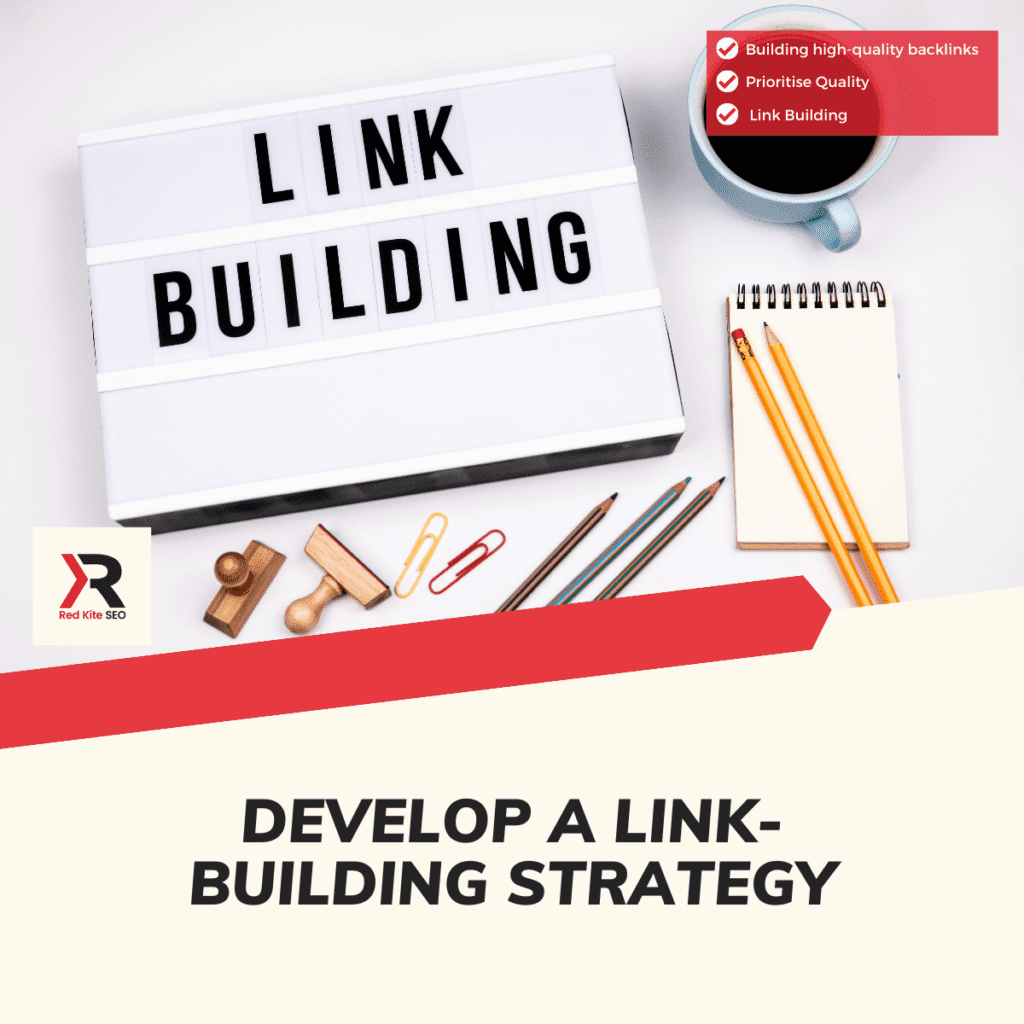
Prioritise Quality: Focus on building high-quality backlinks from trusted sites authoritative sources to enhance website credibility and search rankings.
-
- Seek backlinks from reputable websites within the industry.
- You can reach out to influencers for guest blogging opportunities.
- Collaborate with industry partners for link exchanges.
- Create valuable content to attract natural backlinks.
- Brand links from your branded social profiles.
- Directory links if local from reliable sites.
- Avoid spam links.
- Avoid most automated link building software.
Mobile Optimisation for Today’s Web Search Engine Environment
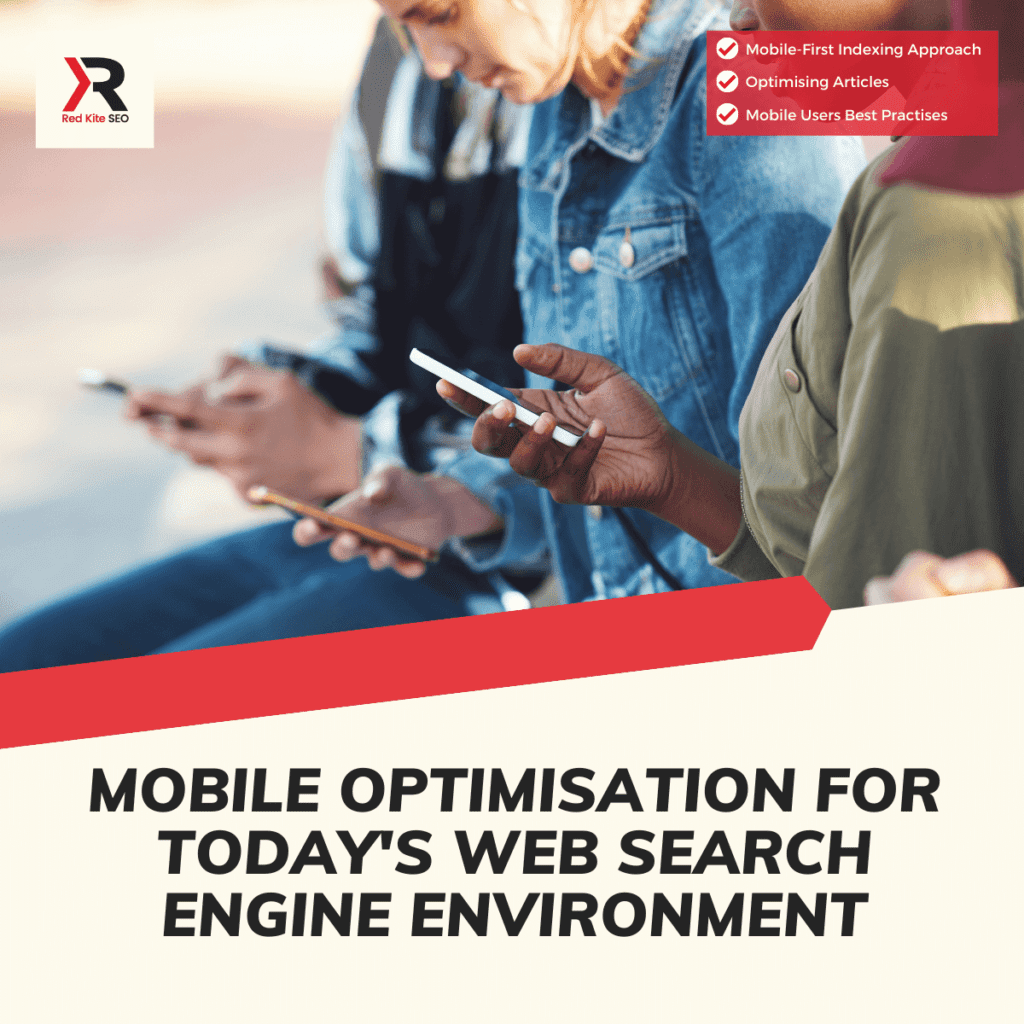
As we continue to steer through the intricacies of SEO for article writing, it’s time to highlight a game-changer in the search engine landscape: mobile optimisation.
With the majority of users now accessing the web on mobile devices, it’s no surprise that Google has adopted a mobile-first approach. But what does that mean for SEO, and more importantly, for your article writing strategies?
Let’s dive into the mobile-first indexing initiative and share essential tips to ensure your content thrives in this mobile-centric world.
Embrace the Mobile-First Indexing Approach
Google’s mobile-first indexing means the search engine primarily uses the mobile version of a website for ranking and indexing. This seismic shift has propelled the need for mobile-friendly content to the forefront of SEO considerations.
As article writers, you must be aware that the performance of your content on mobile devices will largely determine how well it performs. The implication? It’s time to prioritise your site’s mobile experience like never before to maintain and improve your SEO standings.
Optimising Articles for Mobile Users: Best Practises
What can you do to ensure that your articles are designed to appeal to mobile users? Here are a few pointers:
-
- Keep your paragraphs concise to improve readability on smaller screens.
- Use responsive design techniques to make sure your content looks great on all devices.
- Optimise your images to load quickly without sacrificing quality.
- Ensure your buttons and links are easy to click on a small touchscreen.
- Minimise pop-ups that can frustrate mobile users and lead to higher bounce rates.
Remember: Mobile optimisation is no longer optional but a mandatory aspect of article writing for SEO. By integrating these tips into your SEO strategy, you can create a mobile-friendly experience by creating content that not only serves your audience but also aligns with Google’s standards for today’s web environment.
Get Started with SEO Writing Today

By implementing these simple instructions and best practises you can enhance the visibility and relevance of your blog post or posts, driving organic traffic and achieving your business objectives.

Pete Hogg is an accomplished SEO consultant with a proven track record of driving organic traffic and boosting online visibility. With 8 years of experience in the ever-evolving world of digital marketing, he has helped businesses achieve top rankings on search engines. A passionate advocate for SEO best practises, Pete Hogg combines technical expertise with a deep understanding of content strategy to deliver results that matter. When not optimising websites, he enjoys wheelchair rugby. Connect with Pete Hogg to take your online presence to the next level.

